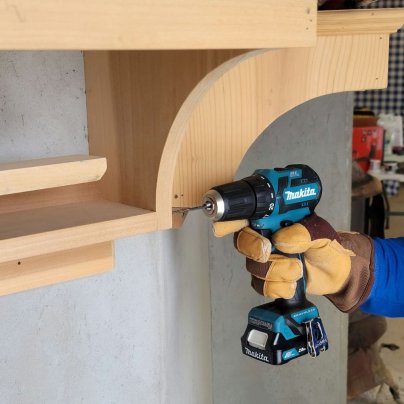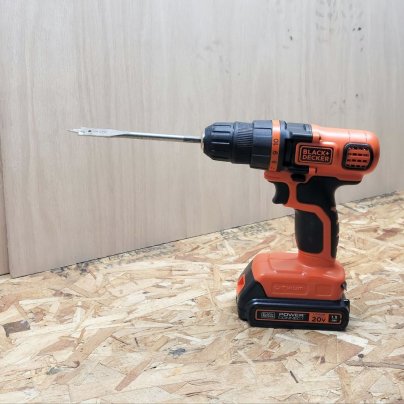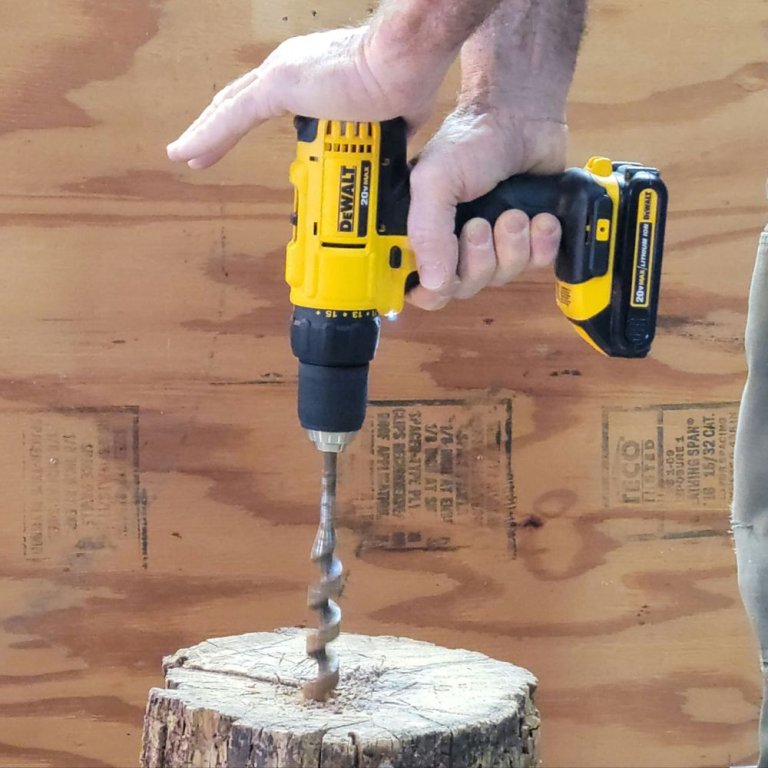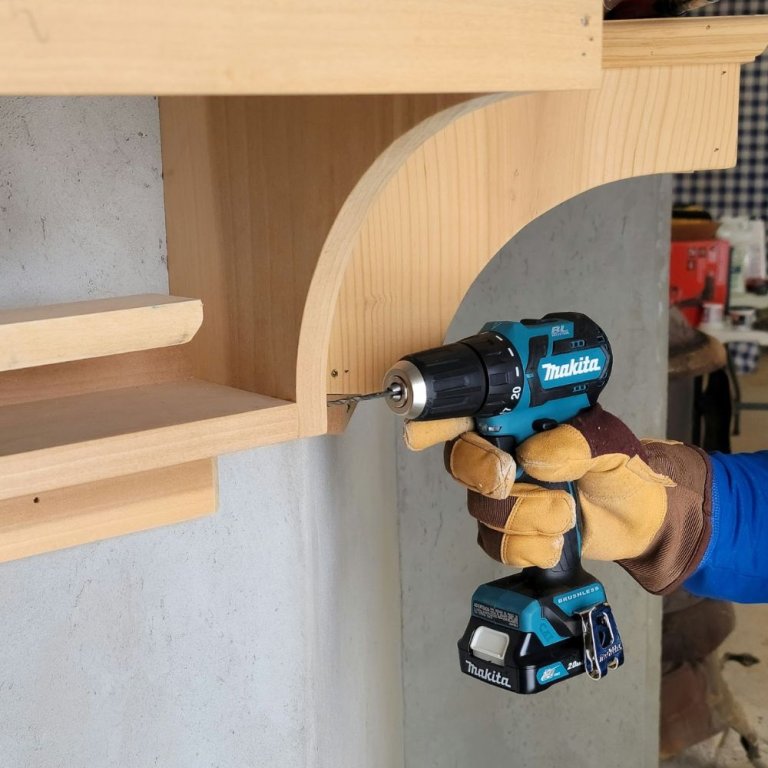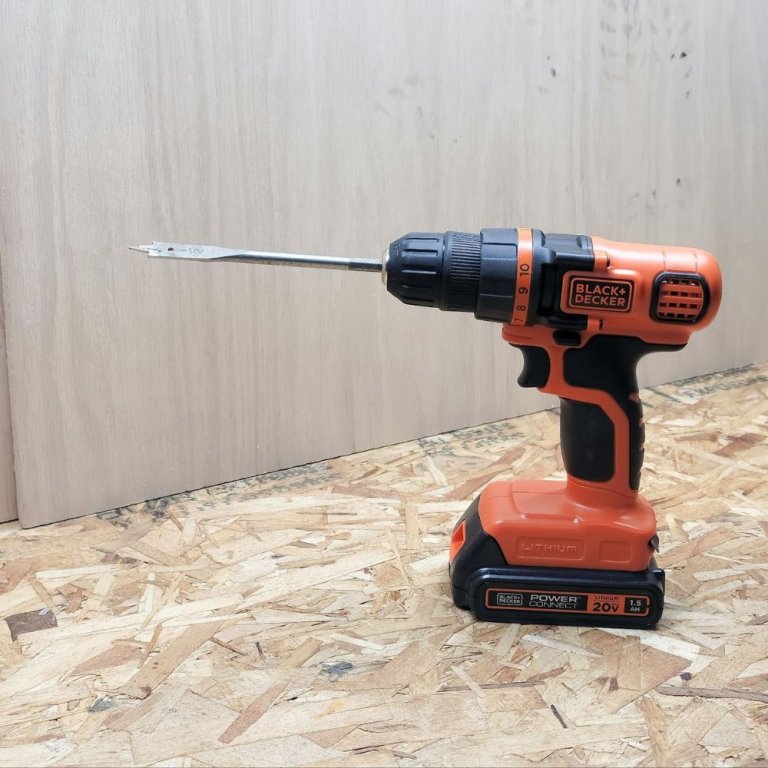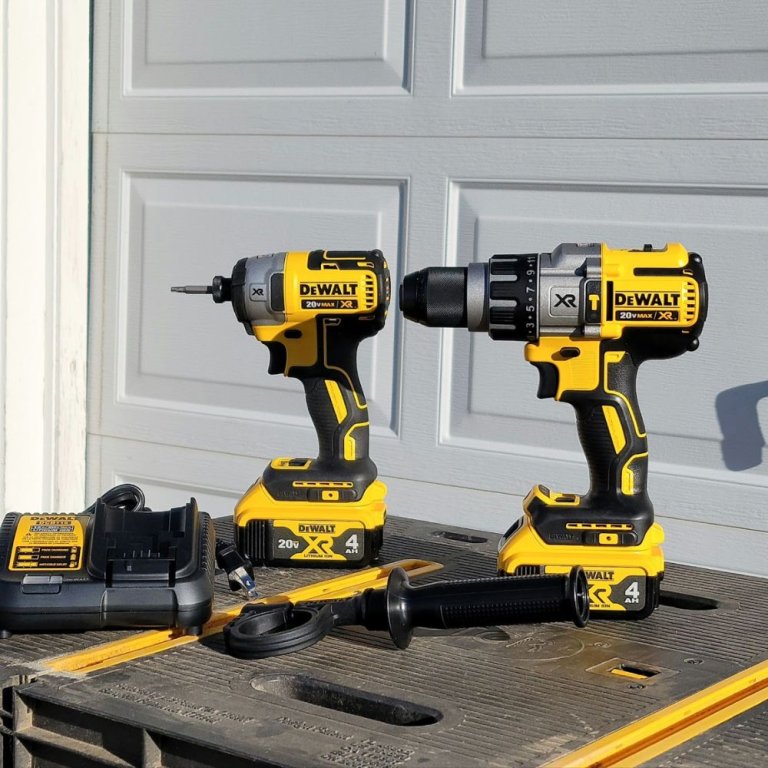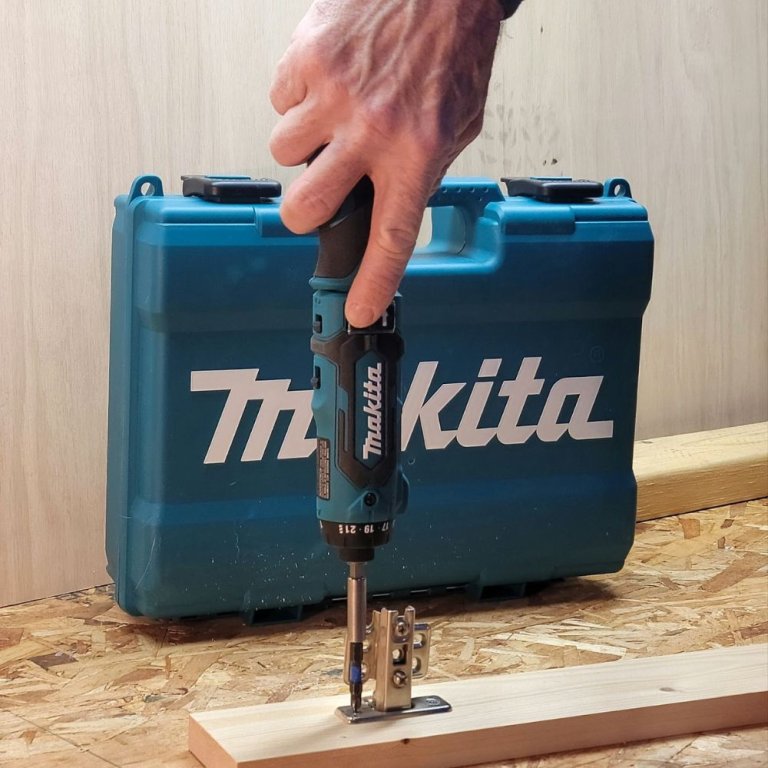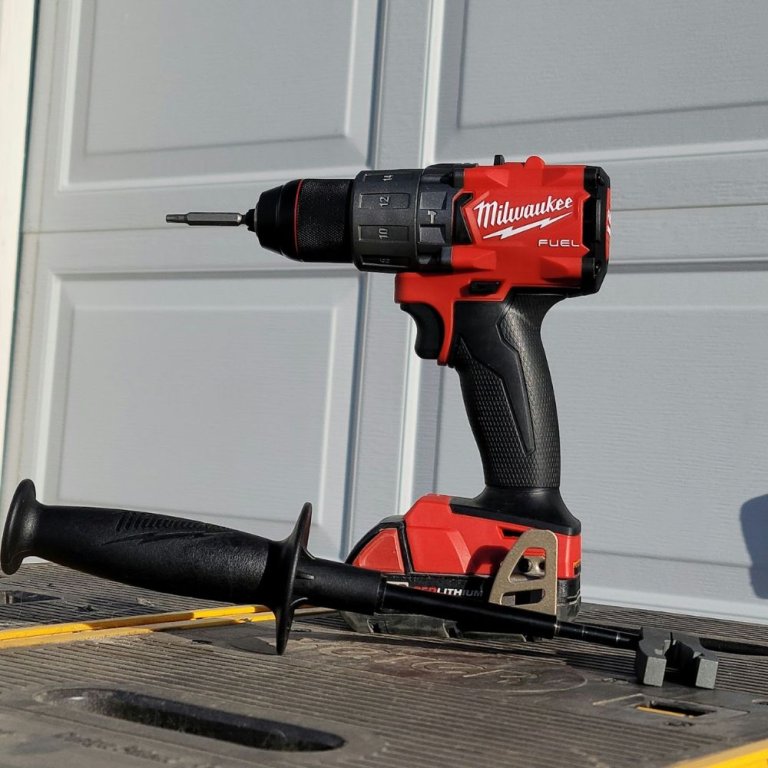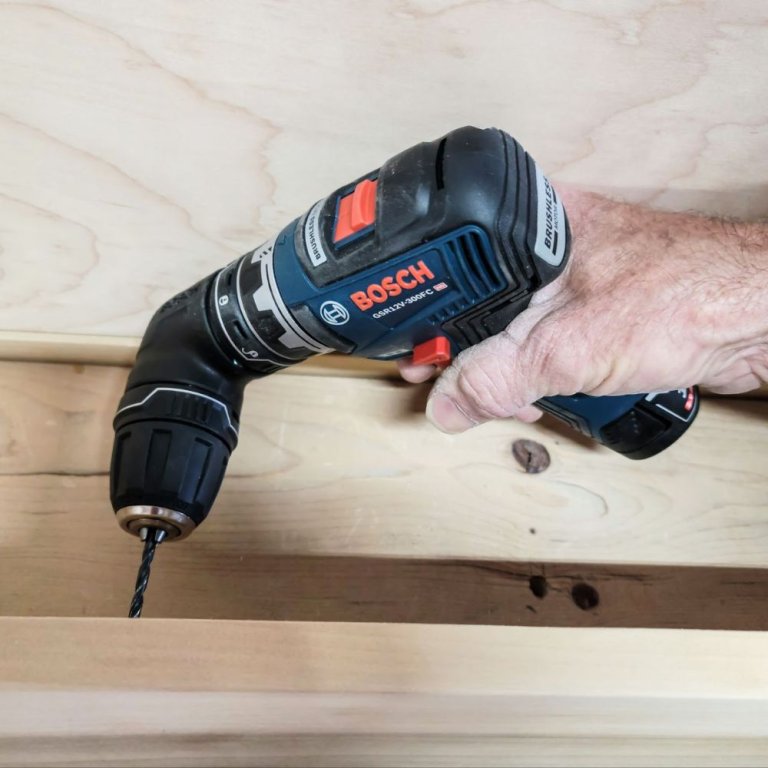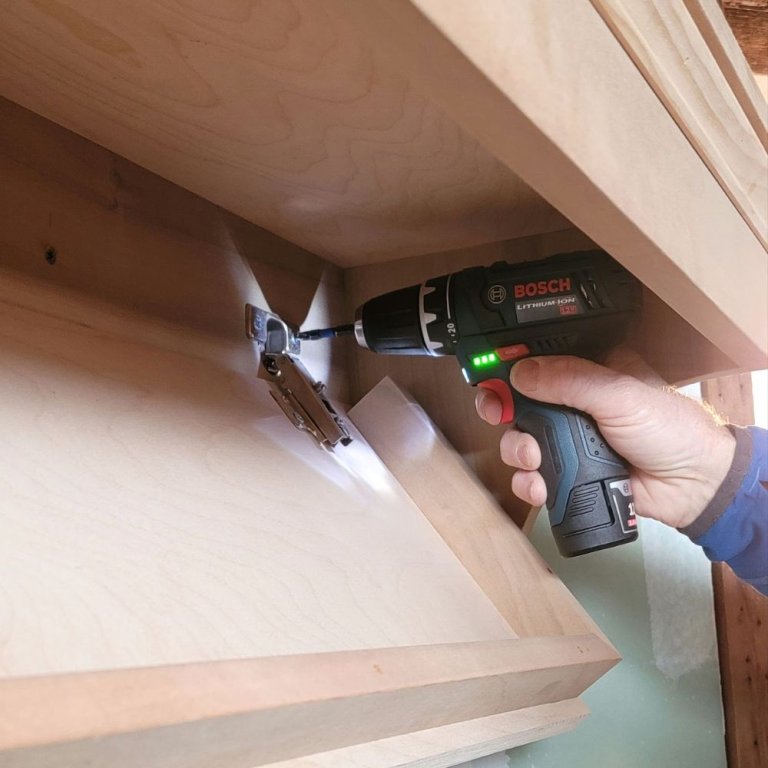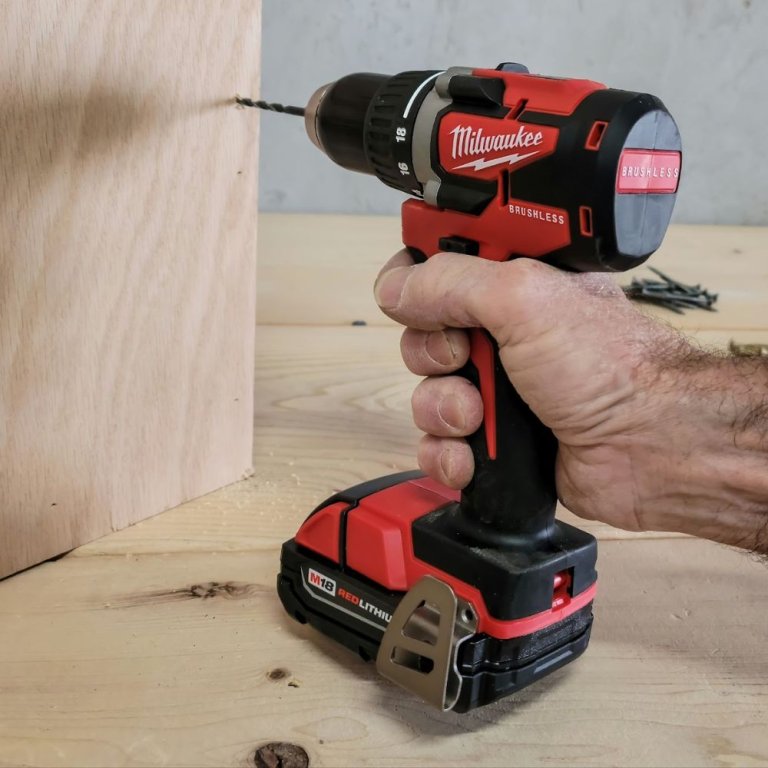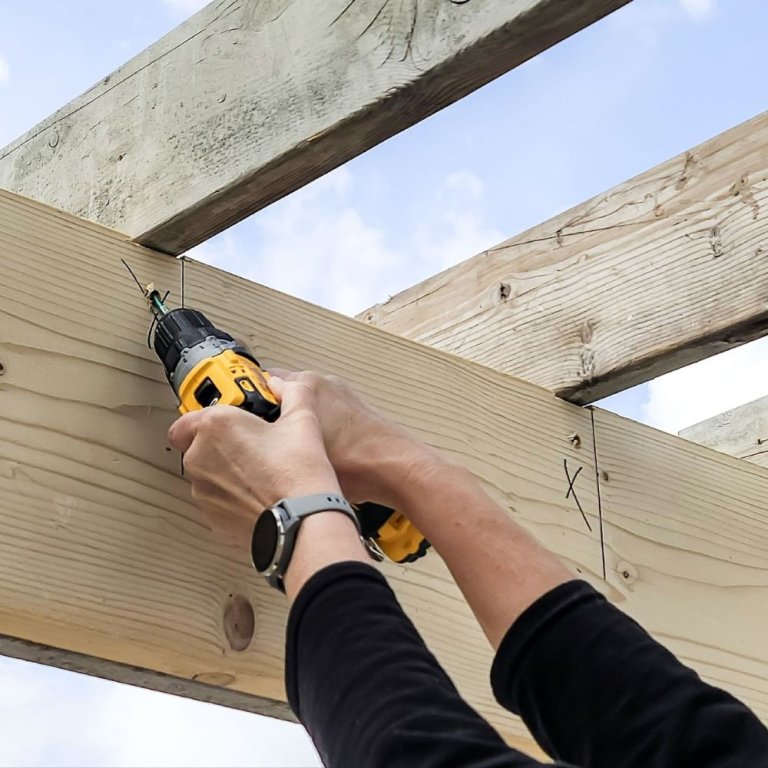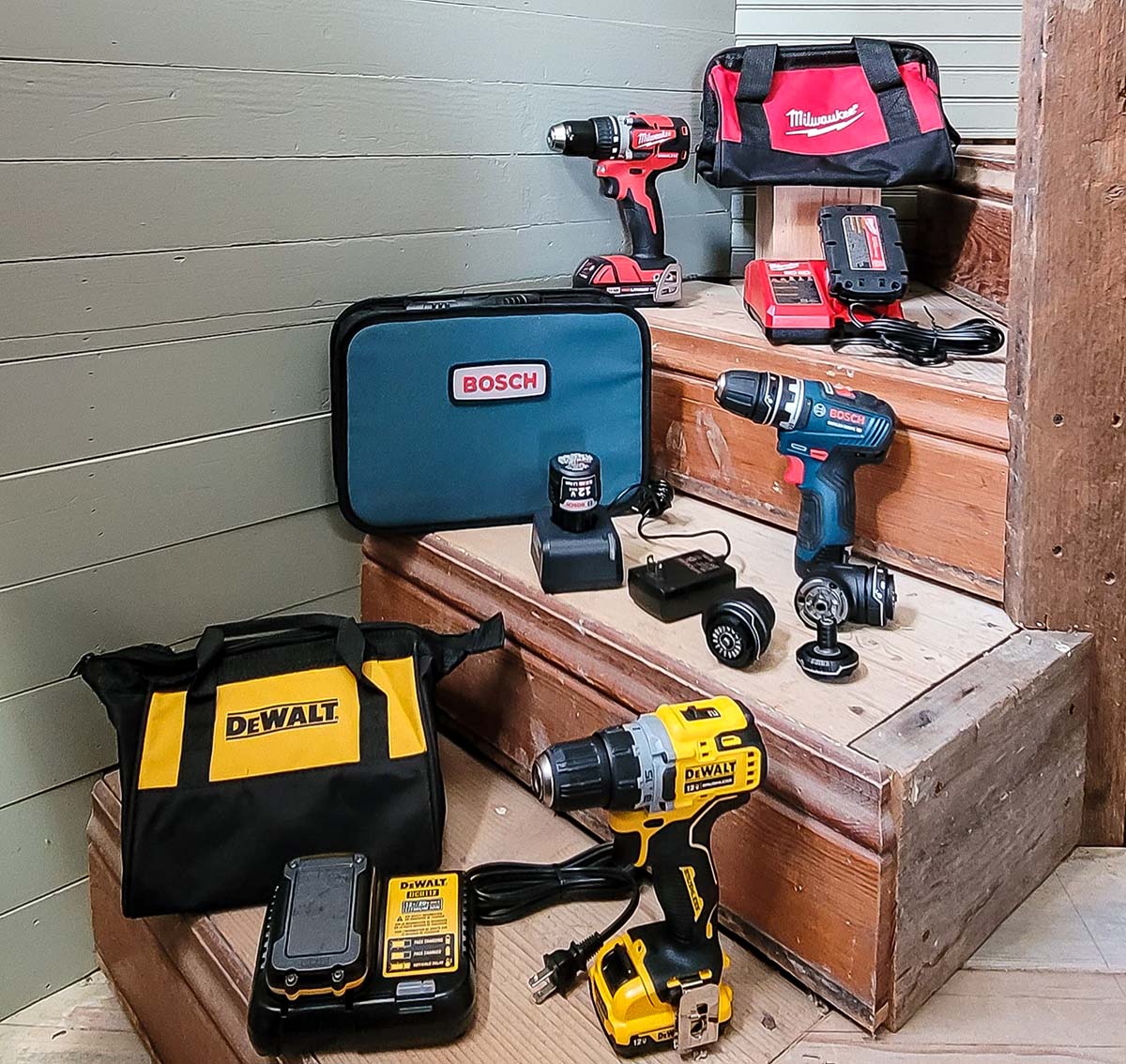
We may earn revenue from the products available on this page and participate in affiliate programs. Learn More ›
With many of today’s tools running on powerful, long-lasting batteries, DIYers aren’t limited by the length of a cord. Cordless tools offer the flexibility and range of movement that’s often needed for tackling most home improvement projects. The popularity of cordless drills, in particular, has brought numerous models to the market, so we wanted to know if our readers were getting what they were paying for. In order to know for sure, we had to personally test the drills, and that’s exactly what we did.
We didn’t pull any punches in our tests—we pushed each drill to its limit and awarded points based on quality, torque, ease of use, and sheer power. We tested each function on every drill to determine the best use for each make and model.
Keep reading to learn how to navigate the options from the cordless drill industry and to find out why each of the following models earned a spot in this lineup.
- BEST OVERALL: DeWalt DCD771C2 20V MAX Compact Drill/Driver Kit
- RUNNER-UP: Makita FD07R1 12V Brushless Cordless Driver-Drill Kit
- BEST BANG FOR THE BUCK: Black+Decker LDX120C 20V MAX Cordless Drill/Driver
- UPGRADE PICK: DeWalt DCK299M2 20V MAX Hammerdrill & Impact Driver
- BEST LIGHT-DUTY: Makita DF012DSE 7.2V Cordless Driver-Drill Kit
- BEST HEAVY-DUTY: Milwaukee 2804-20 M18 FUEL ½-Inch Hammer Drill/Driver
- MOST VERSATILE: Bosch GSR12V-300FCB22 12V MAX Chameleon Drill/Driver
- BEST COMPACT: Bosch PS31-2A 12V MAX ⅜-Inch Drill/Driver Kit
- BEST COMBINATION KIT: Milwaukee 2801-22CT M18 Compact Drill Driver Kit
- ALSO CONSIDER: DeWalt DCD701F2 XTREME 12V MAX Drill/Driver Kit

How We Tested the Best Cordless Drills
To earn a spot in this cordless drill lineup, every power tool was extensively tested. We started by charging the batteries fully, so each drill had a fair shot from the outset. We separated the drills by voltage to remain product-appropriate and performed the most aggressive tests on the highest-voltage drills.
We demanded more from the powerful models—the 18-volt (V) and 20V drills with ½-chucks—because these are the drills DIYers purchase to construct larger projects, such as garages and sheds. We had to know whether they would overheat and how much torque they could generate. We tested each of the 18V and 20V drills using a variety of drill bits—both standard and specialty, such as auger bits and paddle bits—to determine how much power and torque they had. The larger a bit’s surface, such as an auger bit or a 2-inch hole-saw bit, the more power a drill must have to successfully drill through wood and other materials.
We recorded each drill’s performance using a rubric and awarded numbers from 0 to 4. For example, if a drill did not drill through soft pine easily, it got a 0. If it drilled through pine moderately well, we gave it a 2, and if it drilled through pine exceptionally well, it got a 4. At the end, we added up the points from the rubric to get a better overall picture of how well each drill did.
As we drilled holes, we noted each tool’s runtime. However, we did not award points for runtime because lithium-ion batteries may perform better or worse for a variety of reasons, and things like being stored in subfreezing temperatures can reduce their viability. We didn’t feel it would be a fair assessment of the tool to award points on runtime. We did, however, award points for power and torque. We also awarded points based on ergonomics, the ability to adjust clutch settings, and whether they came with additional features—such as work lamps.
For the drills with less voltage such as 12V and 7.2V, we did not subject them to intensive drilling as we did the others. These smaller drills are not designed to withstand that type of activity, so we tested them in practical drilling and driving situations. We used standard drill bits and drilled holes in softwood and hardwood. We noted whether the drills overheated. We adjusted and tested their clutch settings and tested any additional functions.
In the end, we analyzed each drill’s cumulative score, and those that performed the best within their voltage range earned a spot on our best cordless drill lineup. We’re confident that these drills are among the best cordless drills on the market today—for several different types of users.
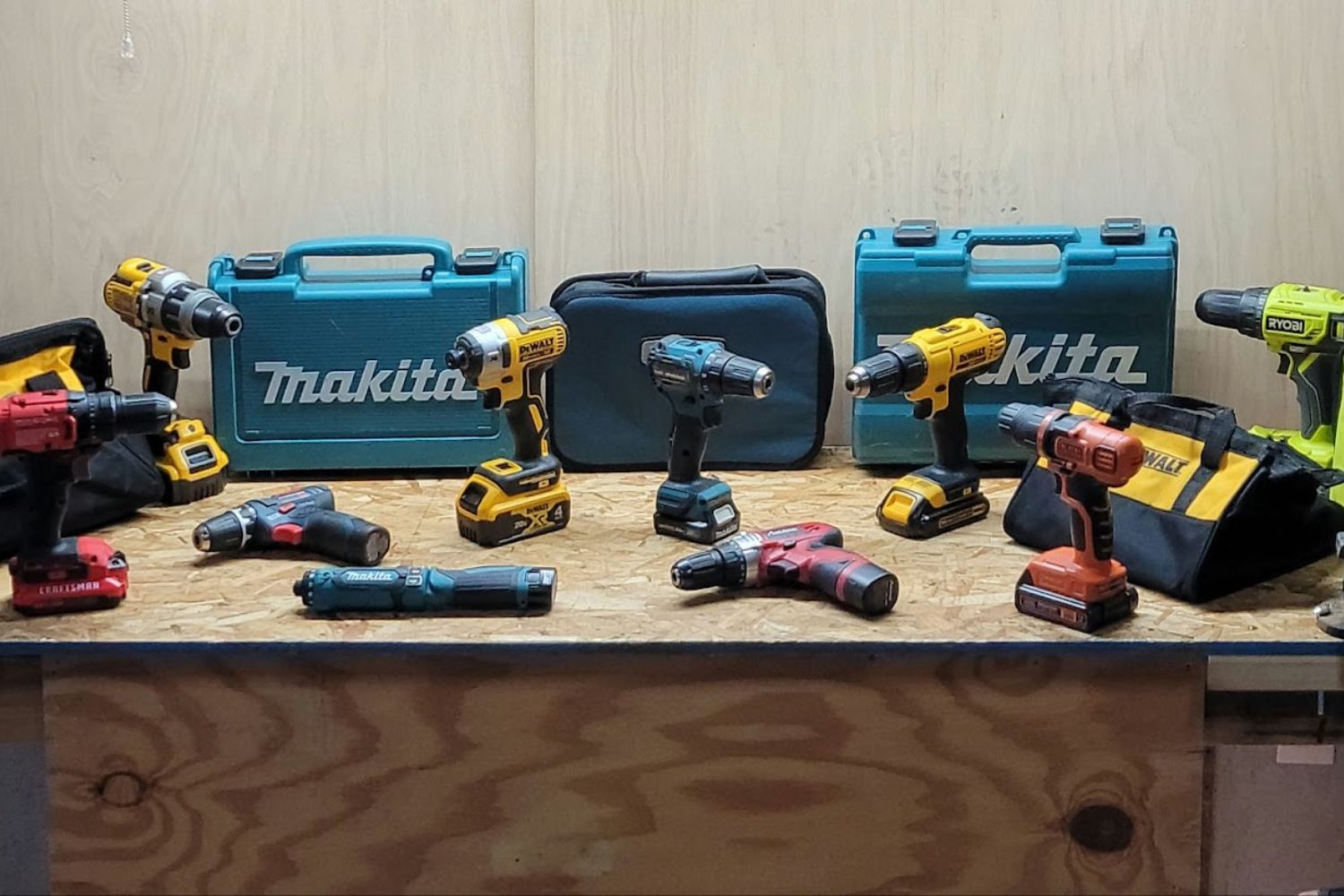
Our Top Picks
The following cordless drills represent many of the top brands, which are known for reliability and value, and we tested each drill on the list. We determined the extent of each tool’s power, whether it could withstand repeated use, its battery life, and the drill’s overall quality. Since some of the following drills are better suited to some tasks than others, we’ve defined the best use for each based on our extensive hands-on testing. Keep reading to find out how each drill performed.
Best Overall
DeWalt DCD771C2 20V MAX Compact Drill/Driver Kit
What We Like
- Versatile construction has a ½-inch chuck, which accepts most screw and drill bits
- 1.3Ah rechargeable lithium-ion battery included; portable and lightweight construction
- Battery charger and contractor carry bag included; keeps all components organized
What We Don’t Like
- Battery capacity is low, but it can be upgraded separately
Product Specs
- Voltage: 20V
- Weight: 3.6 pounds (without battery)
- Speed: Up to 1,500 revolutions per minute (rpm)
This Bob Vila Approved product carries our brand’s highest level of recommendation.
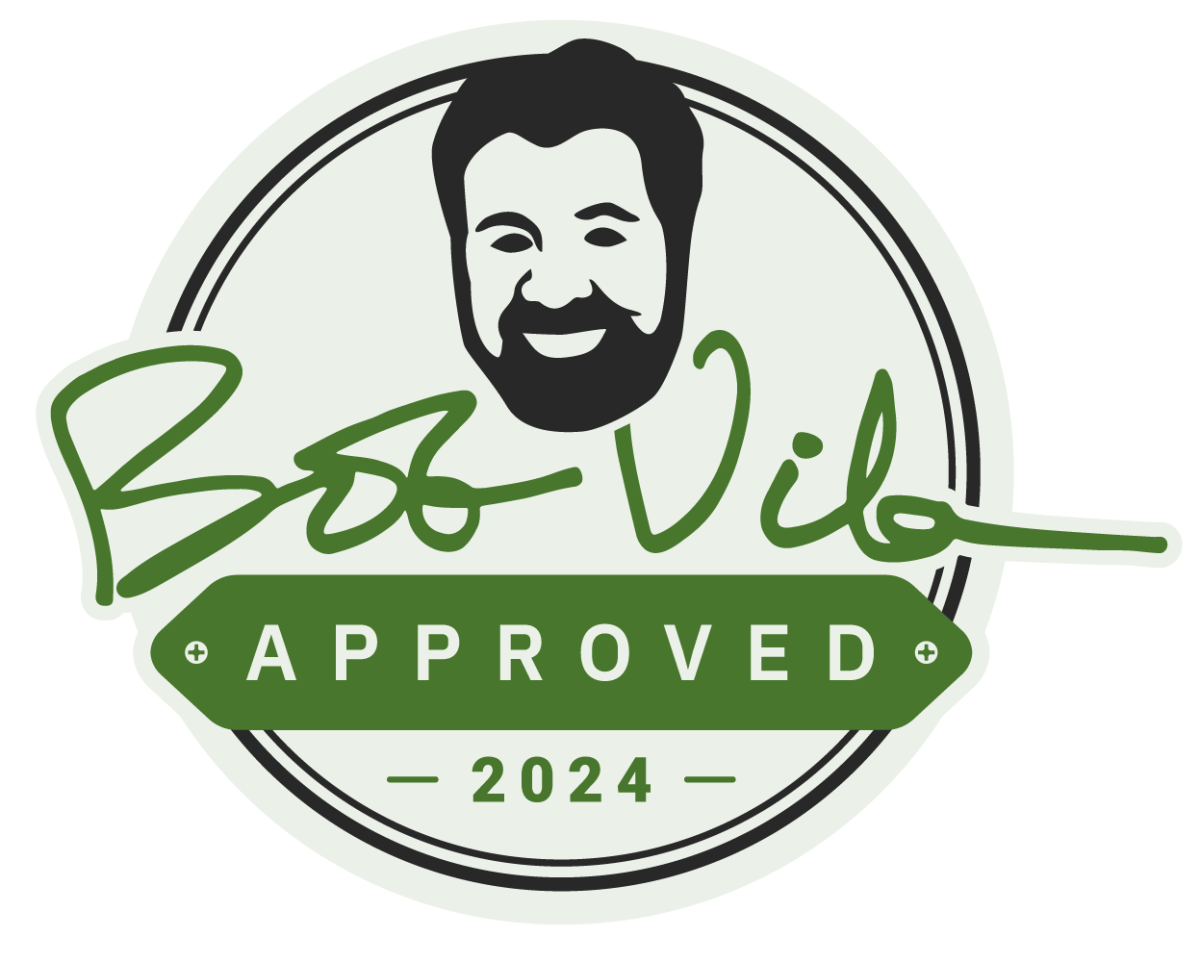
Bob Vila Approved recognizes the household and DIY products that impressed us most in our real-world testing and that exemplify core values of the Bob Vila brand, including craftsmanship, innovation, and value for the dollar. Winners of this designation come recommended by our professional review team and are personally approved by Bob Vila.
DeWalt’s 20V MAX cordless drill/driver comes from one of the most respected names in professional power tools. It offers superb quality and excellent performance at an affordable price, so we couldn’t wait to run it through our battery of tests.
As with all of the drills, the first thing we did was charge the drill’s 20V battery to ensure we had plenty of runtime. We then inserted a ½-inch auger bit and started drilling holes in a tree stump. This DeWalt drill powered right through multiple holes on both low and high speeds. The tool’s grip is comfortable in the hand, and DeWalt has added a bonus palm support on the back of the drill, which allowed us to use our other hand to stabilize the drill and exert pressure on the bit. This is a handy feature for drilling with larger bits.
We switched to a 2-inch hole-saw bit and drilled a dozen or so holes with the DeWalt drill. It powered right through—no loss of torque and no bogging down. After about 55 minutes of solid use, we lost battery power, so we paused to recharge the battery before we tested its driver functions. Keep in mind that runtime is more about the battery than the drill, and things such as the age of the battery and the temperature (lithium-ion batteries don’t run as long in cold temps) can impact runtime.
At 3.6 pounds (without the battery), the DeWalt drill is of moderate weight and well-balanced. The ½-inch chuck is designed to accept most drill and screw bits. An LED light brightens dark corners. The 16 clutch settings allowed us to tweak the torque power for different screw-driving tasks.
DeWalt’s 20V MAX kit comes with a 1.3 amp-hour (Ah) battery, a charger, and a carry bag. Its durability and reliability are among the best in the industry, and this DeWalt cordless drill would make a valuable addition to the tool kit of both DIY enthusiasts and professionals.
Get the DeWalt DCD771C2 cordless drill at Amazon, The Home Depot, or Acme Tools.
Runner-Up
Makita FD07R1 12V Brushless Cordless Driver-Drill Kit
What We Like
- Built-in 20-setting adjustable clutch to fine-tune torque as needed
- 2 batteries included, one to run tool while the other charges
- Brushless motor for long-lasting power and battery life; suitable for DIYers as well as pros
What We Don’t Like
- Pricier than competitive models that have similar power and features
Product Specs
- Voltage: 12V
- Weight: 2.3 pounds (with battery)
- Speed: Up to 1,500 rpm
One of the first things we noticed about this Makita drill was its lightweight, compact size, making it well-suited for smaller jobs. At just 6.5 inches long and 2.3 pounds, with an ergonomic grip to boot, the drill fits comfortably into tight spots where many others won’t. Makita’s brushless motor makes the most of the 12 volts of lithium-ion battery power, which is plenty for everyday tasks, such as drilling holes to hang pictures.
We started with a fully charged battery and inserted a paddle bit. The drill comes with two power settings, and we selected the lowest to have sufficient torque for drilling through our test wood. We drilled dozens of holes and then switched to a hole-saw bit. The 12V 2Ah battery didn’t start to show signs of exhaustion for a full 35 minutes of drilling. Keep in mind that we were drilling holes repeatedly, which put more pressure on the drill than is typical for most situations, so battery runtimes are understandably reduced.
We then swapped in a fresh battery and inserted a driver bit. The compact Makita comes with a 20-setting clutch, so we tested the various torque settings to the screws we were using. This little Makita has slightly less power and torque than the 18V and 20V models we tested, yet it was surprisingly powerful for a 12V cordless drill.
Though it is not an inexpensive cordless drill, this one delivers decent battery life and superior balance, making it well-suited for most DIY projects.
Get the Makita FD07R1 cordless drill at Amazon, The Home Depot, or Ace Tool.
Best Bang for the Buck
Black+Decker LDX120C 20V MAX Cordless Drill/Driver
What We Like
- ⅜-inch keyless chuck for quick, easy bit changes; ideal for use on job sites
- Variable-speed trigger; 11 clutch settings to tweak torque for different tasks
- Built-in LED light for use in low-light situations or for increased visibility
What We Don’t Like
- Light- to medium-duty drill; not suited for heavy drilling
Product Specs
- Voltage: 20V
- Weight: 2.7 pounds (without battery)
- Speed: Up to 650 rpm
We discovered that we didn’t have to spend a lot of money to get a powerful cordless drill. Few brands have a better reputation for balancing quality and value than Black+Decker, and their 20V MAX cordless drill is a great example.
After charging the battery, we started with a hole-saw bit and drilled 2-inch holes in pine. The Black+Decker provided nearly as much power as the more expensive drills in this lineup, but it didn’t have quite as much torque when we exerted a lot of pressure. Not to worry—it’s not designed for heavy-duty drilling. It’s intended for basic around-the-house drilling and driving, and it does that exceptionally well. We tried a variety of bits, and the Black+Decker handled all but the largest auger bit. The battery went out around the 25-minute mark, so we paused to recharge.
With the battery charged again, we switched to driver mode and inserted the screwdriver bit stored on the back of the tool’s handle. The drill offers an 11-setting clutch, which allowed us to tweak the drill’s torque sensitivity when inserting screws.
While this drill will not be powerful enough for a professional framer, it has ample power for many jobs around the home and yard, yet the price is among the lowest on the market. Even though the brush motor helps keep the cost down, Black+Decker didn’t skimp on features in this lightweight ergonomic drill. An LED work light facilitates jobs in dark corners, and a 1.5Ah battery and a charger complete the kit.
Get the Black+Decker cordless drill at Amazon, Lowe’s, The Home Depot, Tractor Supply Co., or Walmart.
Upgrade Pick
DeWalt DCK299M2 20V MAX Hammerdrill & Impact Driver
What We Like
- Kit comes with a hammer drill and impact driver; included batteries are compatible with both
- Ergonomic nonslip grips for comfort and accuracy while in use
- Includes two 4Ah lithium-ion batteries, a charger, and bag
What We Don’t Like
- Plastic leverage bar for the drill might not hold up
Product Specs
- Voltage: 20V
- Weight: 4.7 pounds (drill); 2 pounds (impact driver)
- Speed: Up to 2,000 rpm (drill); up to 3,250 rpm (impact driver)
This DeWalt combo kit may appeal to both DIYers and professionals. The cordless hammer drill makes light work of drilling into tough materials like masonry. The impact driver effortlessly deals with oversize fasteners like deck screws that can sap the energy from even the most powerful standard drill/driver.
We tested the DeWalt hammer drill on concrete and were impressed by its torque and power. We drilled more than a half dozen holes without the hammer drill bogging down or the battery lagging. Our hands and wrists gave out before the hammer drill did—its 20V 4Ah battery just kept going and going. One slight downside is that the included leverage bar is made from relatively lightweight plastic—it’s OK but feels cheap. We attached it to the drill but ended up taking it off and using the drill without it.
The impact driver is impressive. It comes with a compact nose and three speed adjustments. We inserted screws into soft pine without the impact motion kicking in, but when we added pressure and started inserting screws into ash, the impact motion kicked in and added power to insert the screws more quickly. The impact is smooth and rapid—like a well-oiled machine. Like the hammer drill, the battery power of the driver lasted longer than we did. All in all, it’s an excellent set for the money.
The drill has a ½-inch chuck with a durable all-metal 11-position clutch. The impact driver delivers high torque and 3,600 impacts per minute for consistent fast driving of even the largest fixings. Despite their power, each tool weighs in at under 5 pounds.
Get the DeWalt DCK299M2 cordless drill at Amazon, Lowe’s, or The Home Depot.
Best Light-Duty
Makita DF012DSE 7.2V Cordless Driver-Drill Kit
What We Like
- Extremely versatile construction; hinged design to change from pistol grip to straight grip
- 2-speed motor; 21-position clutch for torque control depending on the project
- Built-in LED light for low-light situations and increased visibility
What We Don’t Like
- With just 7.2 volts, this is a light-duty-only drill
Product Specs
- Voltage: 7.2V
- Weight: 1.2 pounds
- Speed: Up to 650 rpm
The standout feature of the 7.2V Makita cordless driver-drill kit is its unique hinged body. DIYers can secure it in a pistol grip like a drill or in-line like an electric screwdriver. Since most cordless drills come with a pistol grip, we were anxious to discover what (if any) benefits the cylindrical grip offered.
With a fully charged battery, we started our tests with the pistol grip and a small paddle bit with a hex shank. It doesn’t accept round-shank bits, which is a bit of a downside. Since the Makita is a 7.2V drill/driver, we didn’t expect it to have as much power as other models we tested. Sure enough, it didn’t, but it’s not designed to rival a professional 20V drill. It’s made to drill holes mostly in wood or drywall, and it does that quite well.
The most significant benefit we found with the in-line grip came when we needed to insert fasteners in tight spots, such as installing cabinet slides or hinges. Here’s where the in-line grip really makes a difference. It doubles as a cordless screwdriver—but with more power. Its 21-setting clutch allowed us to select just the right amount of torque sensitivity for inserting various fasteners before it disengaged. We were also able to choose from two speeds, which increased versatility.
We decided if we were going to have only one drill/driver in the house for handyman-type tasks, we’d choose this Makita model. It’s not a construction drill, but it excels at reaching fasteners in tight spots. We could get nearly 30 minutes out of the drill before the battery ran out and we needed to recharge. The LED light doesn’t just provide illumination; it also flashes when the battery charge gets low.
Get the Makita DF012DSE cordless drill at Amazon, The Home Depot, or Acme Tools.
Best Heavy-Duty
Milwaukee 2804-20 M18 FUEL ½-Inch Hammer Drill/Driver
What We Like
- Brushless motor increases overall power and prolongs battery life
- 14-position clutch allows the user to select optimal torque power
- Provides up to 32,000 beats per minute in impact mode
What We Don’t Like
- Tool-only model; consumers must purchase battery and charger separately
Product Specs
- Voltage: 18V
- Weight: 3.2 pounds (without battery)
- Speed: Up to 2,000 rpm
Milwaukee’s cordless hammer drill offers the kind of heavy-duty performance that, until relatively recently, only corded drills could deliver. We could choose between drilling, driving, or hammer functions from the multifunction collar. The 14-setting clutch gave us the ability to select just the right sensitivity when we switched between large fasteners in hardwood and smaller fasteners in pine. And the ½-inch chuck reflects the tool’s versatility and battery power.
The optional support arm is plastic and steel, but it’s pretty rugged, and because this drill comes with a lot of torque, we appreciated being able to help control it with the support arm. If the drill had jammed when we were using it—it didn’t—the high torque could have resulted in a painful wrist injury.
The Milwaukee handled virtually every test we threw its way—we drilled with a large auger bit; a 1-inch paddle bit; a 2-inch hole-saw bit; and we used it to drive fasteners in hardwood, in pine, and through sheet metal. This product is available as a “tool only,” so the kit doesn’t include a battery or a charger. We used a well-worn 5.0Ah 18V battery from another cordless tool, and we were able to get almost an hour of continuous use. With a new 5.0Ah or a 6.0Ah battery, this cordless drill would be more of a powerhouse than many DIYers need.
Get the Milwaukee 2804-20 cordless drill at Amazon, Ace Hardware, The Home Depot, or Acme Tools.
Most Versatile
Bosch GSR12V-300FCB22 12V MAX Chameleon Drill/Driver
What We Like
- Compact and lightweight, making it handy for overhead use and in tight spots
- Multiple attachments offer added versatility for drilling or inserting fasteners
- Comes with a battery, charger, and all attachments, plus a carry bag
What We Don’t Like
- With just 12 volts, it’s not designed for heavy-duty drilling
Product Specs
- Voltage: 12V
- Weight: 1.4 pounds (without battery)
- Speed: Up to 1,300 rpm
Small but mighty, this Bosch cordless drill came with several quick-change attachments that allowed us to drill holes and insert screws in various settings. We quickly discovered why this Bosch drill features what the manufacturer calls the FlexiClick system: The attachments connect via a simple push-and-click movement that locks them firmly in place. The drill has a standard attachment with a ½-inch chuck that accepts most drill and screw bits. It also has an offset attachment that allowed us to adjust the position of the bit to fit in hard-to-reach spots and an angle attachment that gives the Bosch drill a multiposition head for drilling at various slants.
While this is just a 12V model, we found it had ample power and torque to drill holes in dimensional lumber using even a paddle bit. We also found the 20-position clutch helpful for adjusting the torque to keep from stripping out screw heads in both hardwood and softwood.
The LED guide light isn’t as bright as it could be—it may help slightly, but you will probably want to use a supplemental work light if you’re drilling in low-light situations. The belt clip on this tool is located at the back of the head, which we liked better than the drills with clips located at the base of the handle. It was easier to slip on and off our tool belts. This little drill won’t replace a full-power drill/driver, but it’s an excellent pick for tackling tasks in tight spots.
Get the Bosch GSR12V-300FCB22 cordless drill at Amazon, Lowe’s, or Acme Tools.
Best Compact
Bosch PS31-2A 12V MAX ⅜-Inch Drill/Driver Kit
What We Like
- 20-position clutch offers the ability to fine-tune torque power
- 2 speed settings and variable-speed trigger maximize control while in use
- Built-in LED light offers welcome illumination in dark environments
What We Don’t Like
- ⅜-inch chuck will not accept larger ½-inch drill and screw bits
Product Specs
- Voltage: 12V
- Weight: 1.8 pounds (without battery)
- Speed: Up to 1,300 rpm
We were impressed by both the compact size and the bright LED light on the Bosch cordless drill. It delivers a surprising amount of practical power in a remarkably diminutive package. It weighs a little more than 2 pounds and comes with a ⅜-inch chuck. Two speed ranges provide good versatility for all kinds of drilling and driving tasks. There’s also a battery-charge indicator light on the side.
We tested this model’s drilling power with a paddle bit and regular bits, and it performed flawlessly when drilling in pine. It kept chugging along when we drilled in ash wood, but after drilling dozens of holes in the harder wood, the body of the drill became quite warm. We realized, however, that we were pushing the Bosch drill beyond what it was designed to do. We let it cool down and then tested its driving capabilities.
The 20-setting clutch was the easiest to adjust of all the drills we tested, and it offered a wide range of torque sensitivity. The only downside—and it could be a game changer for some—is how tight the batteries fit. It’s challenging to remove them, and someone without a strong grip might not be able to do so at all.
The Bosch kit includes a pair of 2Ah batteries, a charger, screwdriver bits, and a carry bag. While mainly designed for DIY users, it will also appeal to contractors, particularly those who often work overhead and who don’t need a heavy-duty drill much of the time.
Get the Bosch PS31-2A cordless drill at Amazon, Acme Tools, or Menards.
Best Combination Kit
Milwaukee 2801-22CT M18 Compact Drill Driver Kit
What We Like
- Nonslip ergonomic grip and variable-speed trigger for versatility
- 18-position clutch settings adjust torque when inserting screws
- Bright LED guide light illuminates the work area well
What We Don’t Like
- The clutch adjustment was tight and slightly difficult to turn
Product Specs
- Voltage: 18V
- Weight: 2.5 pounds (without battery)
- Speed: Up to 1,800 rpm
Some of the drills in this lineup require additional purchases, such as a battery or charger, but this Milwaukee compact drill/driver comes with all the components needed to get started. We charged the battery and started testing by drilling holes in hardwood and softwood. It features a brushless motor for added torque and longer battery life, and it easily powered through our drilling tests.
This cordless drill comes with an 18-position clutch that made it easy to adjust the torque power to keep from stripping out screw heads when we tested its driver function. However, we noticed that the clutch ring was pretty tight and took some effort to adjust. Hopefully, it will loosen up with repeated use. It also has a bright LED guide light on the front of the handle just above the grip, and it did an excellent job illuminating the work area when we used it in a dim setting.
The M18 comes with a ½-inch chuck, so most standard drill and screw bits will fit, and the Milwaukee features a handy belt clip on the bottom side.
Get the Milwaukee M18 cordless drill at Ace Hardware, The Home Depot, or Acme Tools.
Also Consider
DeWalt DCD701F2 XTREME 12V MAX Drill/Driver Kit
What We Like
- Provides a long battery life despite being compact and lightweight
- 2 speed transmission settings; 15 clutch settings for correct torque and speed
- Bright LED light stays on for about 30 seconds after triggering
What We Don’t Like
- This 12V drill is powerful for its size but not for heavy-duty use
Product Specs
- Voltage: 12V
- Weight: 1.9 pounds (without battery)
- Speed: Up to 1,500 rpm
The third DeWalt cordless drill to earn a spot on this lineup, the DCD701F2 is lightweight and compact but long on power. It comes with two 12V rechargeable batteries, a charger, and a handy tool bag for carrying and storing the tool.
At 12V and less than 6 inches from back to tip, the DCD701F2 is a subcompact drill, but we had no problem drilling through both hardwood and softwood. It features two speed transmission settings and a bright LED guide light that stayed on for about 30 seconds after we stopped pulling the trigger. We liked this feature since it allowed us to briefly see the work area, even when we weren’t actively drilling.
The drill comes with 15 clutch settings that were easy to adjust and allowed us to insert a variety of screws into materials of varying density without stripping out any screw heads. The DeWalt also has an optional belt clip that can be attached to the tool’s right or left side.
Get the DeWalt DCD701F2 cordless drill at Ace Hardware, Grainger, or Acme Tools.
Jump to Our Top Picks
What to Consider When Choosing a Cordless Drill
Given the tremendous variety of drills available, there are numerous things to consider when choosing the best cordless power drill for you. Consider the following key factors in your search for the best cordless drill for your needs.
Voltage and Amp Hours
Voltage indicates the energy output of a cordless drill, which averages from 7.2 to 20V, although a few higher-voltage drills are out there. The higher the voltage, the more motor power a drill has. How you plan to use a drill will determine how much voltage is needed. Often 12V models make great general-purpose household tools for occasional use.
Avid DIYers and professionals tend to prefer 18V or 20V models. However, there is some natural confusion about 18 and 20V cordless drills. They are, in fact, the same thing. When an electric motor starts up, it gives a quick surge—in this case to 20 volts. It then settles down to its normal running power of 18 volts. Some manufacturers choose to include the smaller figure in the specs, while others include the larger. Nevertheless, in terms of power they are exactly the same. Similarly, the running power of a 12V drill is actually 10.8V.
The most suitable voltage depends on how you plan to use the drill:
- Less than 12 volts: A compact and lightweight tool for those who only have the occasional need for a drill or driver. These models are also popular with hobbyists and model makers.
- 12V: An affordable, general-purpose tool popular with DIYers for a wide range of drilling and driving tasks, such as installing shelves and assembling furniture. Not for heavy-duty use.
- 18 or 20V: Powerful and versatile tools, they might have a hammer action for drilling masonry and can drive longer fixings with relative ease. Heavy-duty slotted-drive-system versions have enough power for home remodeling and professional use, and they can even tackle small demolition tasks.
Beyond the energy output, the battery’s amp-hour rating is important to consider. The higher the Ah, the longer the tool can run. Batteries included with the purchase of a drill typically run 1.3 or 1.5Ah. That’s adequate, but not generous. Models of 3.0 to 4.0Ah provide much more powerful performance for the same price. More powerful 10Ah batteries come at a price point more likely to appeal to professional users who regularly need longer-lasting tools.
Torque and Speed
Powerful motors produce more torque, or twisting force. Rotation speed indicates how many revolutions the drill bit makes per minute (typically between 200 and 1,000 rpm), with slower speeds providing more torque. While a high-speed tool drills faster, a model with more torque can drill through harder materials with larger bits more efficiently.
Most drills have a clutch to temper some of the torque they produce. When a screw being inserted reaches the maximum depth, the clutch disengages the spinning force, preventing the drill bit from stripping out the head of the screw, or worse— catching in the head—which can cause the drill to jerk violently and lead to injury.
Cordless drills offer multiple clutch settings, and most include a variable-speed trigger. Look for a model with at least 10 clutch settings so you can adjust it to the right amount of resistance necessary for a wide array of tasks. Similarly, a drill with two speed settings offers more versatility.
Size, Weight, and Chuck Size
How much a drill’s physical size and weight matters depends on both the user’s physical strength and the intended frequency and length of use. Lightweight models may weigh as little as a pound. Heavy-duty cordless hammer drills might surpass 8 pounds. Although it may be tempting to buy the most powerful tool for a given budget, the extra weight that comes with that power could quickly lead to user fatigue. It’s also worth checking whether the quoted weight includes the battery, because often the weight listed in the tool’s product specs do not.
While many general-purpose cordless drills are quite large, others can be pretty compact without sacrificing power. That’s good to know when it comes to drilling and driving screws in confined spaces.
Just about every cordless drill has a convenient keyless chuck, though chuck size varies. This generally reflects the capabilities of the drill as it governs the maximum size of drill bit that can be inserted. Light-duty models might have a ¼-inch chuck while high-power tools may have a chuck of up to ½ inch.
Brushed vs. Brushless Motor
Corded drills sometimes come with a brushed motor. They are cheap and reliable, but the brushes eventually wear down and require replacement. The other challenge with brushed motors is that they create friction, which runs down the battery more quickly in a cordless model.
The best cordless drills often use a brushless motor. These virtually maintenance-free motors make much more efficient use of the battery. However, brushless motors cost more. As a result, many budget cordless drills still use brushed motors.
For a typical DIYer, the difference is probably negligible. Those who want to maximize performance and runtime, particularly professional users, often choose a brushless cordless drill.
Runtime
Nearly all cordless power tools, including drills, run on rechargeable lithium-ion batteries. A drill battery lasts from as little as 15 minutes to more than 1 hour on a single charge. It can take up to 5 hours for a full recharge, so if a project involves extensive drilling, opt for a kit with backup batteries.
Note that manufacturer statements on runtime often take backup batteries into account. For instance, the specs on a drill that comes with two batteries, each lasting 1 hour, may cite a 2-hour runtime.
Additionally, many cordless drills include a smart charger that replenishes the battery faster, usually within 15 to 60 minutes. A charge indicator allows you to monitor battery capacity.
Additional Features
Depending on how you intend to use the power tool, one or more of the following extras may be worth looking for in a kit.
- A rubberized grip reduces hand and arm fatigue and prevents blisters.
- Some drill handle designs facilitate multiple hand positions for different types of drilling.
- Interchangeable batteries work with other power tools from the same brand.
- Work lights enhance visibility and precision while working.
- Drills with a bit holder offer easier access to bits while using the tool.
- A storage box protects the drill and keeps any additional parts organized.
Shopping for a Used or Refurbished Cordless Drill
Historically, most people would balk at the idea of spending good money on a used or secondhand tool, but today’s refurbished models are not the dubious equipment found at a neighborhood yard sale. For some time, reputable manufacturers and retailers have been offering refurbished or renewed products like cordless drills alongside new models.
The idea is that when a commercially viable fix is possible, it cuts down on waste—which is always a good thing. It may also offer buyers the opportunity to acquire products that might otherwise be outside their budget.
These should not be tools that have been beaten to death for 364 days and returned on the day the warranty expires. It’s true that often they have been tried by another buyer but will have been returned within a relatively short return window. Other times, they might be tools damaged in transit or in the warehouse.
So are refurbished drills any good? In our opinion, yes. There’s every chance they could represent a real bargain. There are some interesting offers on refurbished or renewed drills at Amazon and Walmart, among others. However, care and common sense is needed.
- Specify the type of cordless drill you want first. Look at new models. Then see what you can get on the refurbished market that comes close to those specifications.
- Keep a tight rein on your budget. It’s easy to get carried away. The idea here is to save money or get better value.
- You should be looking for a substantial cost reduction. If the price is saving only 10 percent or 15 percent, it might be better to buy new.
- Make sure you know exactly what is included. Cordless tools often won’t include a battery or charger, for example.
- Be sure to check warranty and return periods before you order. Don’t make assumptions, even if you’ve bought from the retailer before.
While refurbished, reconditioned, or renewed tools are often excellent, there’s always a chance it could be a dud. Buy from a reputable source. Check the drill as soon as it arrives so you can get your money back if there’s a problem.
FAQs
Our in-depth investigation of technologies and specifications above may have you feeling better equipped to choose the best power drill for your needs. That valuable information is underlined by examples of some of the top cordless drills currently available. Nevertheless, with so many options available, a few questions might remain. The following are answers to some of the most common questions.
The primary use of a cordless drill is for drilling holes and driving screws. However, you can also get numerous attachments. There are stirrers for mixing paint and other liquids. You can also attach a sanding drum, a wire brush for rust removal, or a polishing bonnet. We have produced a handy guide to cordless drill uses here.
Corded models were once more powerful tools. But today, equally powerful cordless models rival them. However, cordless models lose some of their power over the course of the charge while corded models perform at a consistent level for as long as they’re plugged in.
An electric screwdriver is usually much smaller, has less power, and cannot drill holes. The cordless drill can make holes and also drive screws.
New and improved models enter the market all the time, so it’s difficult to say which brand is best overall. Brands with a reputation for high quality tools include Bosch, DeWalt, Makita, and Milwaukee. However, almost all modern cordless drills are pretty durable and reliable.
It very much depends on the amp hours of the battery and how hard the drill is working. A battery can last as little as 15 minutes, though many will run between 30 minutes and 1 hour. Buying a spare battery allows you to simply swap one out and carry on working while the other charges.

